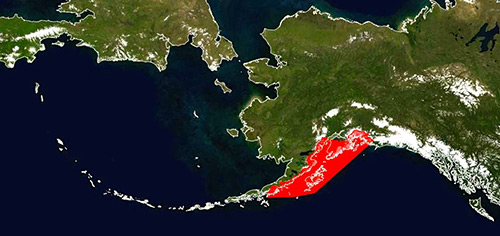
The Exxon Valdez - 25 Years LaterBy JULIE COHEN
December 11, 2014
UC Santa Barbara’s National Center for Ecological Analysis and Synthesis (NCEAS) has collaborated with investigators from Gulf Watch Alaska and the Herring Research and Monitoring Program to collate historical data from a quarter century of monitoring studies on physical and biological systems altered by the spill. Now, two new NCEAS working groups will synthesize this and related data and conduct a holistic analysis to answer pressing questions about the interaction between the oil spill and larger drivers such as broad cycles in ocean currents and water temperatures.
The red area shows the extent of the 1989 Exxon Valdez oil spill.
One working group — Understanding Changes in the Coastal Gulf of Alaska Social-Ecological System: Analysis of Past Dynamics to Improve Prediction of Future Response to Natural and Anthropogenic Change (CGoA Futures) — will determine how the structure, productivity and dynamics of socioeconomic and ecological systems in the Gulf of Alaska responded to anticipated changes in environmental conditions and human disturbances. This working group will consist of two linked subgroups, one studying socioeconomic aspects and the other ecological systems. Both will use statistical and modeling approaches to understand mechanisms of change — and the changes themselves. The findings of each group will be coupled in order to create an overview of past changes and potential futures for the entire area. Principal investigators of the CGoA Futures group include Thomas A. Okey of the University of Victoria’s School of Environmental Studies; Terrie Klinger of the University of Washington’s School of Marine and Environmental Affairs; James J. Ruzicka of Oregon State University’s Cooperative Institute for Marine Resources Studies; and Amber Himes of the National Oceanic and Atmospheric Administration’s Alaska Fisheries Science Center and the University of Washington’s School of Marine and Environmental Affairs. The second working group — Applying Portfolio Effects to the Gulf of Alaska Ecosystem: Did Multiscale Diversity Buffer Against the Exxon Valdez Oil Spill? — will evaluate evidence for an oil spill signal among a suite of species, focusing specifically on crabs, groundfish, salmon, herring and the lucrative fisheries they support. The researchers will also investigate the broader food web context using plankton, marine mammals and seabird datasets. The investigators will use time series modeling approaches to determine the forces driving variability over time in these diverse datasets. They will also examine the influences of multiple drivers, including climate forcing, species interactions and fishing. By evaluating species’ life history attributes, such as longevity and location, and linking them to how and when each species was impacted by the spill, the researchers may help predict ecosystem responses to other disasters and develop monitoring strategies to target vulnerable species before disasters occur. The second working group is led by Kristin Marshall of the University of Washington and the NOAA’s Northwest Fisheries Science Center; Anne Beaudreau of the University of Alaska Fairbanks; Richard Brenner of the Alaska Department of Fish and Game; NCEAS Associate Mary Hunsicker; and Eric Ward and Ole Shelton of the NOAA’s Northwest Fisheries Science Center. A newly appointed postdoctoral associate, Rachael E. Blake of Louisiana State University, who will be in residence at NCEAS for two years beginning in January 2015, will assist the working groups and conduct an assessment of the relative importance of multiple stressors in near-shore habitats in the Gulf of Alaska. “The kind of holistic synthesis being done by these working groups is critical to guide future monitoring and recovery initiatives, which are expected to continue for decades, and to inform monitoring design and policy responses in case of future spills,” Davis said.
Related:
Julie Cohen
Source of News:
|
||
